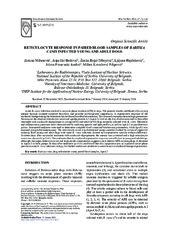Приказ основних података о документу
Reticulocyte response in paired blood samples of Babesia canis infected young and adult dogs
| dc.creator | Milanović, Zorana | |
| dc.creator | Ilić Božović, Anja | |
| dc.creator | Bojić-Trbojević, Žanka | |
| dc.creator | Hajduković, Ljiljana | |
| dc.creator | Francuski Andrić, Jelena | |
| dc.creator | Kovačević Filipović, Milica | |
| dc.date.accessioned | 2024-02-01T12:23:54Z | |
| dc.date.available | 2024-02-01T12:23:54Z | |
| dc.date.issued | 2024 | |
| dc.identifier.issn | 1409-7621 | |
| dc.identifier.uri | https://vet-erinar.vet.bg.ac.rs/handle/123456789/3631 | |
| dc.description.abstract | Acute B. canis infection can lead to an acute phase reaction (APR) in dogs. The parasite invades red blood cells causing anemia through immune-mediated hemolysis and possible erythropoietic suppression. A regenerative response of the erythroid lineage during the babesiosis has not been described in extension. This research examines hematologic parameters focusing on the absolute reticulocyte count and apolipoprotein A I (ApoA I) level on the day of admission and 14 days after treatment with imidocarb-dipropionate in young (n=11) and adult (n=11) dogs naturally infected with B. canis. Metabolic and inflammatory processes were characterized by analyzing protein and lipid profiles, as well as ApoA I at specified time points. Automated analyzers were used to determine complete blood count and biochemical parameters, while ApoA I was assessed using radioimmunoassay. The reticulocyte count was determined using a manual method by means of supravital staining. Both young and adult dogs with acute B. canis infection showed non-regenerative anemia without difference. Fourteen days after successful treatment with imidocarb-dipropionate, the anemia was corrected and a high reticulocyte count was observed (p<0.05). This indicates that the erythroid regenerative response was efficient in young and adult dogs, although vital signs, leukocyte count and triglyceride concentration suggest a more intense APR in young dogs. A decrease in ApoA I in both groups 14 days after treatment (p<0.01) confirmed that this lipoprotein acts as a positive acute-phase protein in acute B. canis infection in dogs, but further studies are needed to connect its role in erythroid lineage regeneration. | sr |
| dc.language.iso | en | sr |
| dc.publisher | Saints Cyril and Methodius University of Skopje, Faculty of Veterinary Medicine | sr |
| dc.relation | info:eu-repo/grantAgreement/MESTD/inst-2020/200143/RS// | sr |
| dc.rights | embargoedAccess | sr |
| dc.source | Macedonian Veterinary Review | sr |
| dc.subject | Babesia canis | sr |
| dc.subject | dog | sr |
| dc.subject | reticulocyte count | sr |
| dc.subject | paired blood samples | sr |
| dc.subject | ApoA I | sr |
| dc.title | Reticulocyte response in paired blood samples of Babesia canis infected young and adult dogs | sr |
| dc.type | article | sr |
| dc.rights.license | ARR | sr |
| dc.citation.volume | 47 | |
| dc.citation.issue | 1 | |
| dc.identifier.doi | 10.2478/macvetrev-2024-0011 | |
| dc.identifier.fulltext | http://veterinar.vet.bg.ac.rs/bitstream/id/10867/bitstream_10867.pdf | |
| dc.type.version | acceptedVersion | sr |

